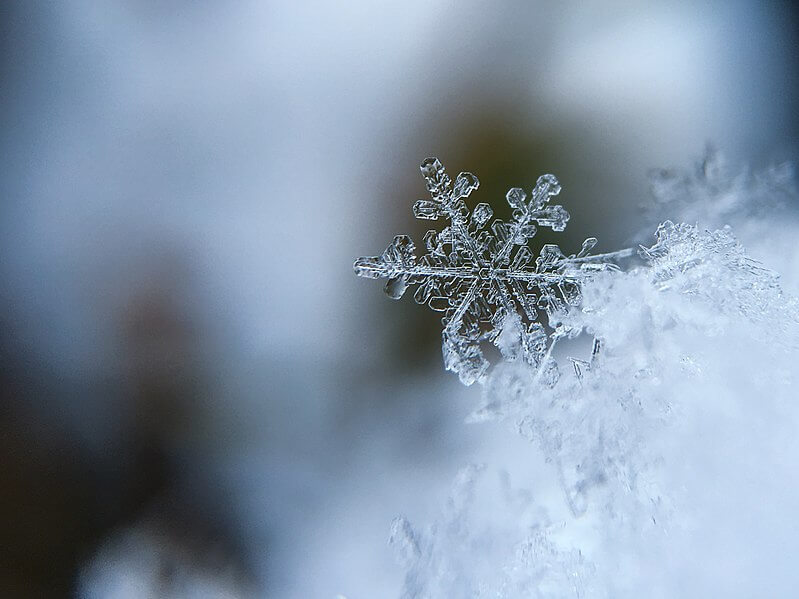The Silence of Snow
By Kathleen Carey
Broadcast 12.2003, 1.2006, 11.2007, 12.2009, 1.2012, 2.2020, 12.7 & 12.10.2022

Photo by Aaron Burden, public domain.
Listen:
Walking in a heavy snowstorm at night is one of my favorite ways to experience winter. There is something magical about being wrapped in a hug of falling snow. Snowflakes land delicately and melt on the tip of my nose. The trees are covered in a lacy latticework of icy crystals. The world slows down for a while and becomes quiet, save for the scrape of shovels on driveways and sidewalks, or the thwop of snow as it slides en masse from roof to yard.
Bundling up in my scarf, hat, thick down coat, and two pairs of gloves, strapping on my leather boots, and taking that first step into a snowstorm creates a deep sense of calm throughout my entire body. Silence. Walking through my neighborhood, the sky glowing pink with city lights, I am always so struck by the muted silence of falling snow. The sounds I do hear seem to be amplified—the crunch and squeak beneath my feet, the patter on my head, and the rustle of the trees if a breeze is blowing. Inevitably I think to myself: why does snow generate such a distinct absence of sound? What creates that muffled quality? And what causes the other unique sounds of snow?
Trying to actually answer my musings turned up some interesting explanations. I discovered that large, fluffy snowflakes consist of many randomly-aligned surfaces that disperse sound waves very effectively. When a sound wave encounters a snowflake, either in the air or on the ground, it is reflected in many directions, bouncing around in the insulating air spaces and quickly losing energy. Instead of being reflected in a specific direction it becomes scattered in many directions; the effect is similar to the acoustic baffles used in sound-proof walls. Therefore, snowflakes absorb sound, creating the distinct quiet of a heavy snowfall and allowing sounds close by, such as the crunching beneath my feet, to seem intensified.
While silence is the quality of snow I cherish the most, I also learned that underwater creatures experience snow very differently, being subjected to an auditory assault every time a snowflake melts. Scientists have discovered that when a snowflake falls on water, two distinct sounds are created. First there is a “plink” generated by air bubbles released when the snowflake hits the surface. Second, there is a high-pitched “screech” as the snowflake melts and releases the air bubbles trapped within its crystals, a “nivean death-throe cry,” as one meteorologist put it. Emanating at a frequency of 50-200 kilohertz, well out of the range of human hearing, this “screech” may even be heard by porpoises and dolphins. Collectively, the snowflakes of a heavy snowfall could raise the noise level underwater by up to 30 decibels, the difference between an office conversation and a jackhammer. The quiet of my snowstorm may end up being a noisy cacophony for catfish and trout.
Now, when I am walking in a snowstorm, perhaps by a creek or lake, and am savoring the gentle quiet, I will also remember the chorus of melting snowflakes nearby.
Every week since 1991, Field Notes has inquired about Montana’s natural history. Field Notes are written by naturalists, students, and listeners about the puzzle-tree bark, eagle talons, woolly aphids, and giant puffballs of Western, Central and Southwestern Montana and aired weekly on Montana Public Radio.
Click here to read and listen to more Field Notes. Field Notes is available as a podcast! Subscribe wherever you listen to podcasts.
Interested in writing a Field Note? Contact Allison De Jong, Field Notes editor, at adejong [at] montananaturalist [dot] org or 406.327.0405.
Want to learn more about our programs as well as fun natural history facts and seasonal phenology? Sign up for our e-newsletter! You can also become a member and get discounts on our programs as well as free reciprocal admission to 300+ science centers in North America!












